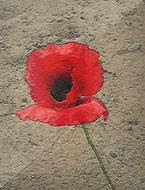My middle child ordered an "afghan or coverlet" for Christmas. I don't know whether or not I'll be able to finish it in time, but will certainly try. I dislike knitting afghans, or crocheting them for that matter. I have a number of squares laying around the house, all different sizes, some from the Great American Afghan booklet, and I doubt whether or not they'll ever end up in a finished afghan.
On some of the German sock lists and blogs I follow, folks have been knitting afghans out of left over sock yarn. Some one posted the instructions on her blog and, of course, I promptly forgot to copy the blog address. That's the reason for not being able to credit her. It is simply the granny dishcloth knit with two strands of sock yarn. Start with 3 stitches, increase 1 stitch by making a yarn over at the beginning of each row until 90 stitches are on the needle and then decrease back to 3 stitches and finish off by slipping one stitch, knitting 2 together and passing slipped stitch over. Voila! one square done.
I have never had good luck with the granny dishcloths; the edges never looked good enough as far as I was concerned. So this time around, I experimented a bit and finally came up with the right combination. The instructions state to knit the yarn over through the back loop on the way back. This is what the patch looks like when doing this:

Check the difference between the bottom edge and the side edge. The bottom edge shows the yarn over knit simply through the back loop on the return row, while the side edge shows how the edge looks on the yarn-over side.

Another view of the problem. It's OK for a dish cloth, but not for an afghan for daughter and her dear husband.
The next step was to twist the yarn-over before knitting into it. This took care of the problem, but involved an extra step to manipulate the stitch. So here is what I came up with. Instead of making the yarn-over from front to back, I make it from back to front. Then on the return row, I put the tip of the needle into the front leg of the yarn-over, from left to right, twisting the yarn over. This allows me to knit the stitch in one operation, rather than lifting the yarn-over from the needle and manually twisting it before knitting. Leave it up to a lazy person to spend time on such a minor thing. But, I think, it will save me time knitting 24 patches. (These instructions are for Continental knitting. English knitters are on their own.)
And here is the result:

Now doesn't that look much better? Both sides now are the same.
And here is a pic of the second patch finished so far.

The third patch has been started, but I need to finish up a pair of socks first.
Knit on, merrily!
 The oak leaves turned late this year, but are more colorful than in previous years. This view is toward the street showing the end of the drive way.
The oak leaves turned late this year, but are more colorful than in previous years. This view is toward the street showing the end of the drive way.  This oak sapling looks like it will definitely grow into a mighty oak some day. This view is from the back of the house.
This oak sapling looks like it will definitely grow into a mighty oak some day. This view is from the back of the house.  And, of course, where there is sun, there are the Japanese beetles.
And, of course, where there is sun, there are the Japanese beetles.  And if you look closely you can see the horns on this young buck which came to visit the other day.
And if you look closely you can see the horns on this young buck which came to visit the other day. 















